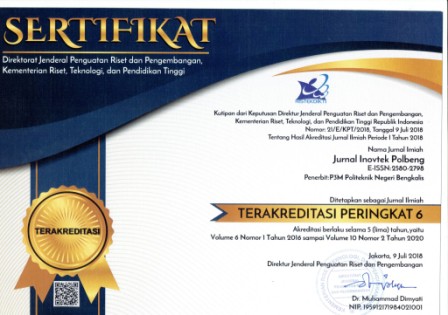Peningkatan Performa 4 Stroke SI Engine menggunakan Voltage Stabilizer untuk Kontrol AFR
Abstract
The manufacturer's rules apply Euro 3 and Euro 4 as an effort to reduce emissions in the air. The standard input voltage for the Engine Control Unit (ECU) is 12V to produce an ideal Air to Fuel Ratio (AFR) at a value of 14.7. However, in machine operation in the field, the voltage supplied by the battery cannot be constant at that number and causes the AFR to change too, especially in open-loop ECU systems. The input voltage that is too low can affect the AFR to be too high. The condition might cause the engine temperature to be too high and decreases engine performance. As a solution to this problem, this research develops a voltage stabilization mechanism (VC) to facilitate the setting of air and fuel for the engine to be constant at the desired value. To get the best AFR value, engine performance is tested with dyno tests including power, torque, fuel oil consumption, and AFR. The test results show that the best engine performance value reaches 16.7 HP at 10000 RPM and 13.35 Nm of torque at 8000 RPM, and a voltage of 12.5 V and AFR 14.11. The AFR value is used as input to the VC system, and the equipment can adjust the voltage automatically to stabilize the AFR at a predetermined value.
Keywords
Full Text:
PDFReferences
N. Kawahara, S. Hashimoto, and E. Tomita, “Spark discharge ignition process in a spark-ignition engine using a time series of spectra measurements,†Proc. Combust. Inst., vol. 36, no. 3, pp. 3451–3458, 2017.
G. Yufeng and F. Zongde, “Experimental Study on Different Ignition System Matching Different Spark Plug Gap,†Comput. Intell. Nat. Comput. Int. Conf., vol. 1, pp. 305–308, Jun. 2009.
D. Jung and N. Iida, “An investigation of multiple spark discharge using multi-coil ignition system for improving thermal efficiency of lean SI engine operation,†Appl. Energy, vol. 212, pp. 322–332, 2018.
G. J. Rohwein, “An efficient, power-enhanced ignition system,†IEEE Trans. Plasma Sci., vol. 25, no. 2, pp. 306–310, 1997.
A. Nishiyama and Y. Ikeda, “Improvement of lean limit and fuel consumption using microwave plasma ignition technology,†in SAE Technical Papers, 2012.
S. Tsuboi, S. Miyokawa, M. Matsuda, T. Yokomori, and N. Iida, “Influence of spark discharge characteristics on ignition and combustion process and the lean operation limit in a spark ignition engine,†Appl. Energy, vol. 250, no. May, pp. 617–632, 2019.
“Spark ignition engine.†pp. 1–17, 2011.
M. Hese, H. Tschöke, T. Breuninger, F. Altenschmidt, and H. Winter, “Influence of a Multispark Ignition System on the inflammation in a Spray-guided Combustion Process,†SAE International Journal of Fuels and Lubricants, vol. 2, no. 2. Consiglio Nazionale delle Ricerche, pp. 376–386, 2009.
A. Zhang et al., “The Impact of Spark Discharge Pattern on Flame Initiation in a Turbulent Lean and Dilute Mixture in a Pressurized Combustion Vessel,†SAE International Journal of Engines, vol. 6, no. 1. SAE International, pp. 435–446, 2013.
M. Chiaberge, G. Botto, and M. De Giuseppe, “An FPGA controlled DC/DC step-up converter for automotive applications,†EPE J. (European Power Electron. Drives Journal), vol. 23, no. 3, pp. 30–35, 2013.
“DBNSTJ : Development of a Battery-Voltage-Driven Fuel Injector for Direct-Injection Gasoline Engines.†[Online]. Available: https://dbnst.nii.ac.jp/english/detail/1783. [Accessed: 25-Nov-2020].
P. Pourmohamadiyan, A. Hassanpoor, A. Soheili, E. Afshari, and K. Hooman, “A new automatic spark generation system for gasoline engines,†in Proceedings of the IEEE International Conference on Industrial Technology, 2016, vol. 2016-May, pp. 1016–1021.
K. Linkenheil, H. O. Ruoß, T. Grau, J. Seidel, and W. Heinrich, “A novel spark-plug for improved ignition in engines with gasoline direct injection (GDI),†IEEE Trans. Plasma Sci., vol. 33, no. 5 II, pp. 1696–1702, Oct. 2005.
DOI: https://doi.org/10.35314/ip.v11i1.1715
Refbacks
- There are currently no refbacks.
Copyright (c) 2021 INOVTEK POLBENG
This Journal has been listed and indexed in :

inovtek polbeng by http://ejournal.polbeng.ac.id/index.php/IP is licensed under a Creative Commons Attribution-ShareAlike 4.0 International License









